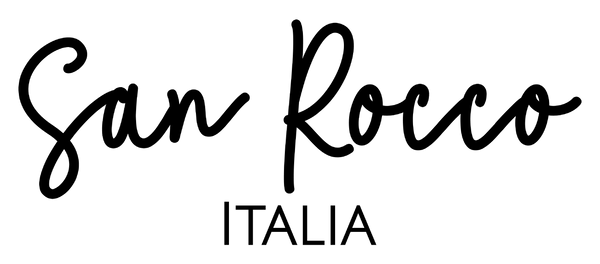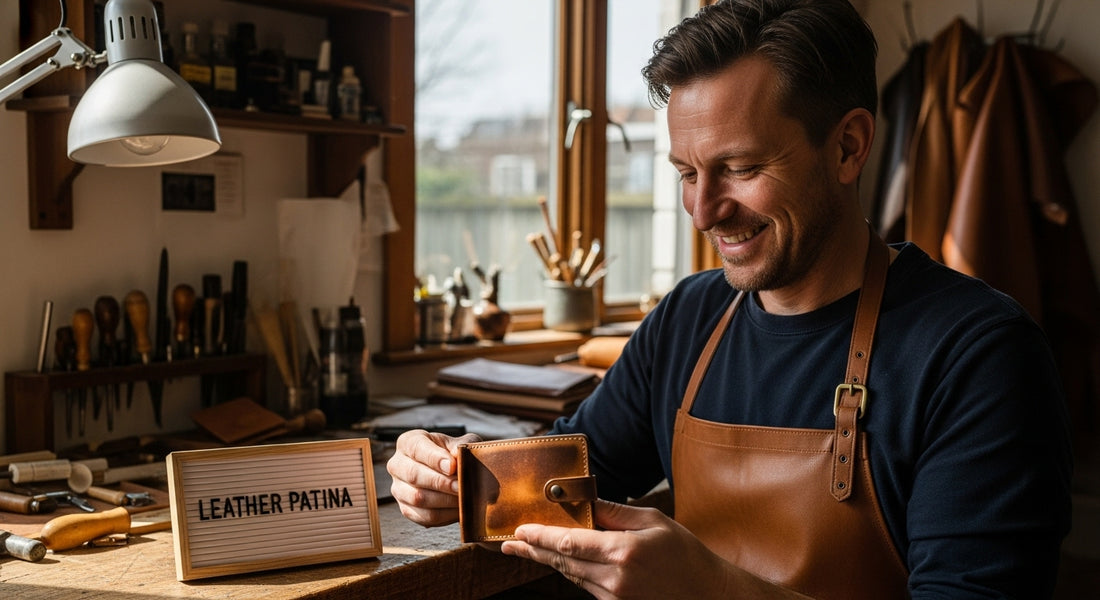
Understanding Vegetable Tanned Leather Patina: Beauty Unveiled
Share
Vegetable tanned leather patina is more than just a surface change. Over time, it transforms ordinary leather goods with a warm glow and subtle shifts in tone that reflect your daily life. But here is something most people miss. Unlike chrome-tanned leather which stays mostly the same, vegetable tanned leather becomes more visually rich and unique each year, developing a patina that only improves with age. The real surprise is how this slow evolution turns every leather item into a personal keepsake, each mark telling part of your own story.
Table of Contents
- What Is Vegetable Tanned Leather Patina?
- The Significance Of Patina In High-Quality Leather
- The Process: How Vegetable Tanning Influences Patina
- Key Characteristics Of Patina In Italian Leather
- Maintaining And Appreciating Your Leather’s Patina
Quick Summary
| Takeaway | Explanation |
|---|---|
| Patina reflects the leather’s unique journey | Patina marks the personal history of the leather, evolving with use and environmental interactions. |
| Vegetable tanning enhances leather quality | This natural process develops a stable structure that allows for rich, aesthetic evolution over time. |
| Maintain moderate environmental conditions | Protect leather from extreme temperatures, humidity, and sunlight to preserve its distinctive patina. |
| Embrace the imperfections of patina | Each mark and colour shift adds character to the leather, making it a cherished personal artifact. |
| Gentle care nurtures leather’s evolution | Regular, minimal conditioning and careful use contribute positively to the leather’s ongoing development. |
What is Vegetable Tanned Leather Patina?
Vegetable tanned leather patina represents a remarkable transformation that occurs naturally in high-quality leather, revealing a unique narrative of elegance and character through its evolving surface. Unlike artificially treated leather, vegetable tanned leather develops a distinctive aesthetic that tells the story of its journey, becoming more beautiful with each interaction and use.
The Natural Aging Process
The patina process begins with the traditional vegetable tanning method, which utilises natural tannins extracted from tree bark, leaves, and plant materials. This technique creates a leather surface that is incredibly responsive to environmental conditions and personal use. Research on sustainable leather production demonstrates how these natural tanning processes enhance the leather’s ability to develop a rich, nuanced appearance over time.
Key characteristics of vegetable tanned leather patina include:
- A gradual colour transformation from its original tone
- Development of unique surface variations and subtle sheen
- Enhanced visual depth and character with continued use
Understanding the Visual Evolution
As leather ages, it absorbs oils, experiences sunlight exposure, and encounters various environmental interactions. These experiences create a personalised surface that reflects the leather’s history.
The patina develops organically, creating a visual record of the item’s journey. Each mark, slight colour shift, and textural change contributes to the leather’s individual narrative, making vegetable tanned leather pieces truly unique.
The remarkable quality of vegetable tanned leather lies in its ability to improve aesthetically with age, unlike synthetic or chrome-tanned alternatives that tend to degrade or maintain a static appearance.
To clarify the key differences between vegetable tanned leather and chrome-tanned leather regarding patina development and overall appearance, the table below offers a direct comparison.
| Feature | Vegetable Tanned Leather | Chrome-Tanned Leather |
|---|---|---|
| Patina development | Gradual and unique; improves with age | Minimal change; remains mostly static |
| Visual evolution | Warm glow, subtle shifts in tone | Retains original appearance |
| Narrative & character | Tells a personal story | Lacks individual character |
| Response to environment | Highly responsive | Comparatively unresponsive |
| Emotional and aesthetic value | Increases over time | Remains unchanged or diminishes |
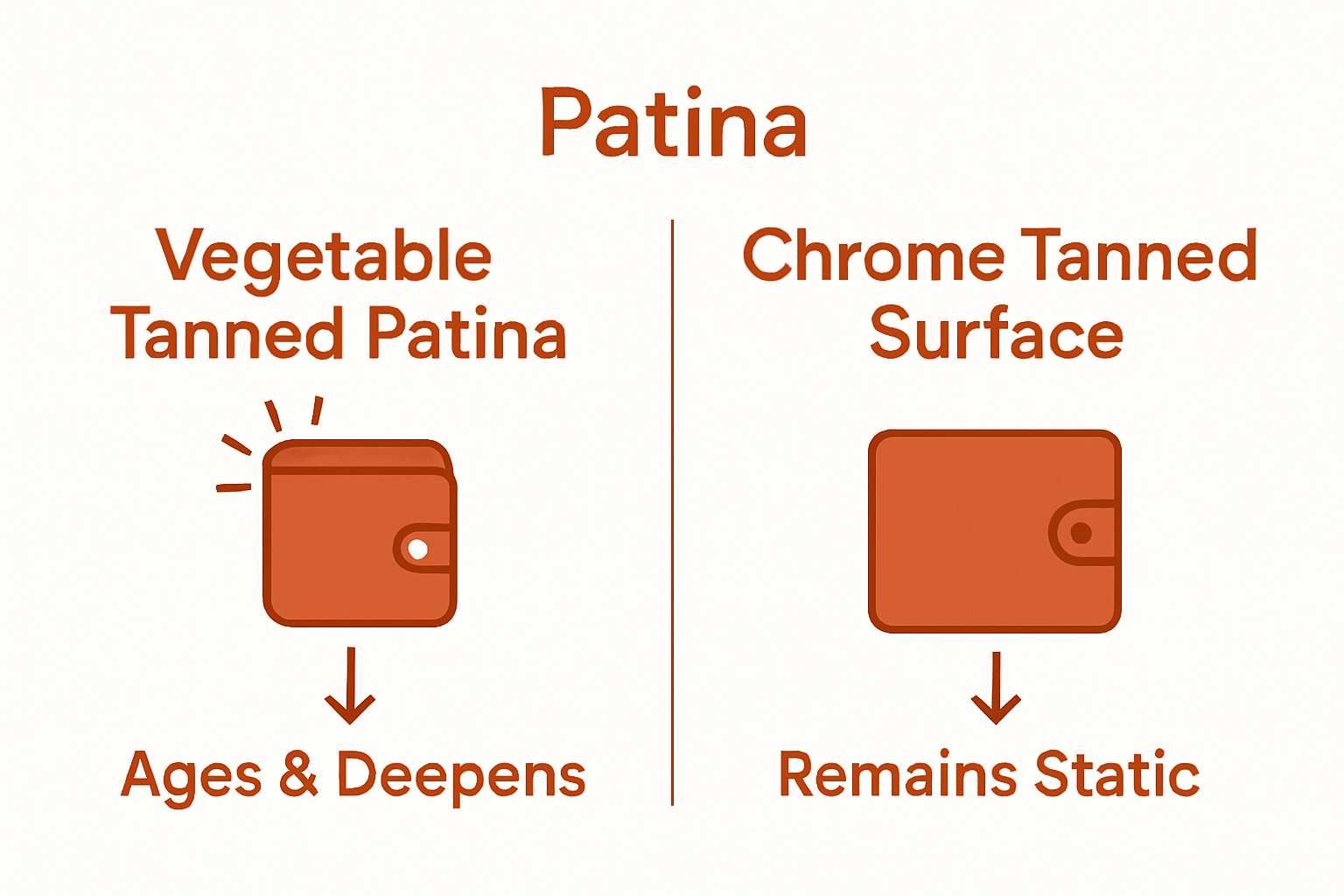 This natural aging process transforms a simple leather item into a cherished possession with deep personal significance.
This natural aging process transforms a simple leather item into a cherished possession with deep personal significance.
The Significance of Patina in High-Quality Leather
Patina represents more than a superficial change in leather appearance; it is a profound testament to craftsmanship, quality, and the intimate relationship between an object and its owner. In the realm of luxury leather goods, patina serves as a powerful indicator of authenticity, artisanal excellence, and the inherent value of meticulously crafted materials.
Beyond Surface Aesthetics
The development of patina goes far beyond mere visual transformation. Research examining leather deterioration reveals that patina is a complex interplay of chemical and environmental interactions that reflect the leather’s intrinsic quality. High-quality vegetable tanned leather responds to these interactions by developing a rich, nuanced surface that tells a unique story.
Key indicators of superior leather patina include:
- Gradual and uniform colour evolution
- Increased surface luminosity and depth
- Retention of structural integrity during aging
The Emotional and Cultural Significance
Patina transcends technical attributes, embodying an emotional narrative of ownership and experience. Each subtle shift in colour, each delicate mark represents a moment in the leather’s journey. This organic aging process transforms a mere accessory into a personal artifact with deep sentimental value. Unlike mass-produced items that deteriorate, vegetable tanned leather develops character, becoming more beautiful and meaningful with time.
The true significance of patina lies in its ability to bridge craftsmanship, personal history, and aesthetic appreciation. It represents a living testament to the enduring quality of artisanal leather production, where each piece becomes a unique reflection of its individual journey.
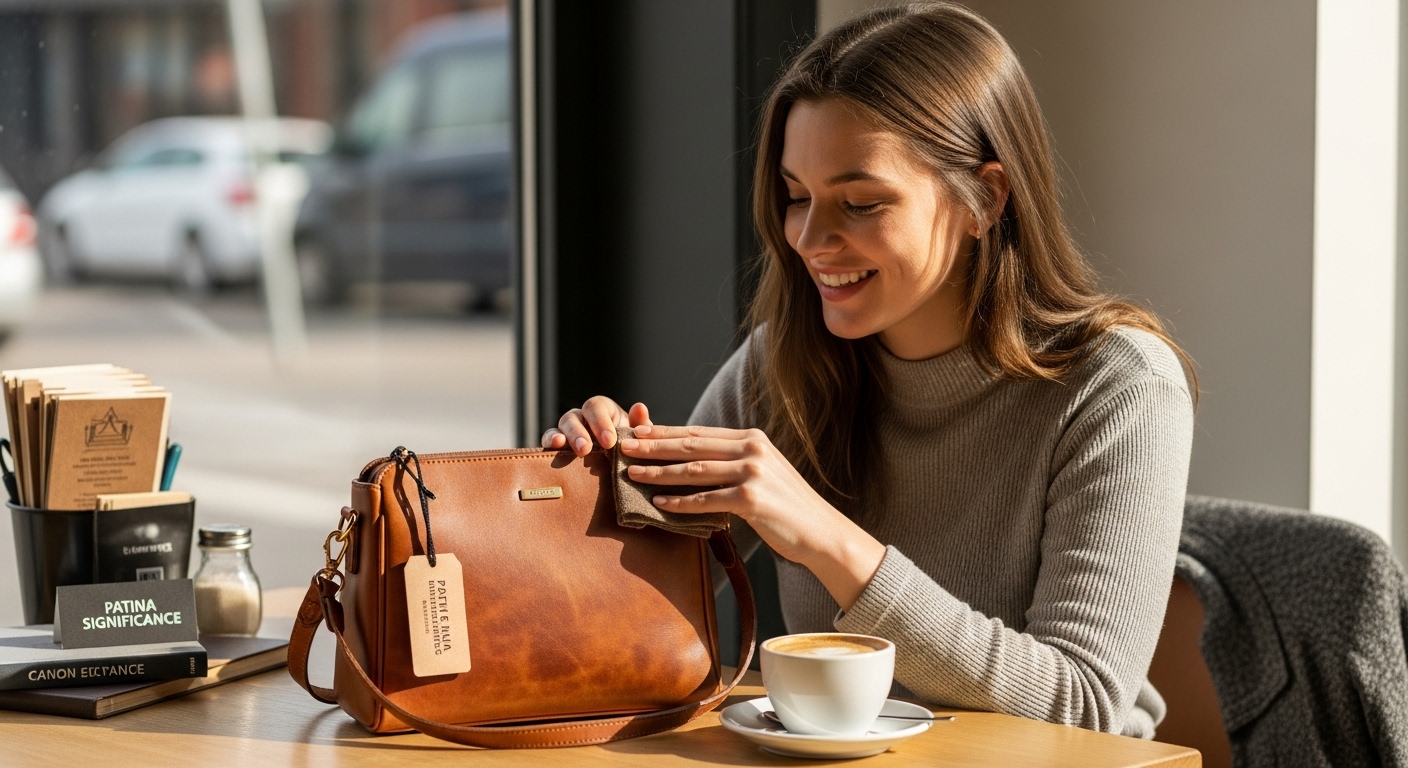
The Process: How Vegetable Tanning Influences Patina
Vegetable tanning represents an ancient craft that transforms raw animal hide into a living material capable of developing a rich, evolving patina. This intricate process involves using natural tannins extracted from plant materials, creating a leather surface that is not only environmentally sustainable but also remarkably responsive to environmental interactions.
The Chemical Transformation
Research on sustainable leather production reveals the complex chemical interactions that occur during vegetable tanning. Natural tannins extracted from tree bark, leaves, and other plant sources bind with collagen proteins in the leather, creating a stable molecular structure that enables future color and texture transformations.
Critical stages of the vegetable tanning process include:
- Careful selection of natural tannin sources
- Precise temperature and pH control during tanning
- Gradual absorption of tannins into leather fibres
Molecular Interactions and Aesthetic Development
The vegetable tanning process establishes a foundational molecular architecture that enables leather to interact dynamically with its environment. As the leather ages, it absorbs oils, experiences temperature variations, and encounters different levels of humidity. These interactions trigger subtle chemical changes that contribute to the leather’s unique patina.
Unlike synthetic tanning methods that create static surfaces, vegetable tanning produces a leather that essentially becomes a living material. Each interaction leaves a nuanced mark, transforming the leather from a mere object into a personal artifact with a distinct narrative and visual depth. The result is a material that improves aesthetically and structurally with age, reflecting the remarkable potential of traditional craftsmanship.
Key Characteristics of Patina in Italian Leather
Italian leather patina represents a sophisticated manifestation of craftsmanship, combining centuries of artisanal tradition with nuanced material science. This unique aging process transforms leather from a mere material into a living artifact that captures personal history and exceptional quality through its evolving surface characteristics.
Structural and Visual Transformations
Research examining leather stability reveals that authentic Italian leather patina involves complex molecular interactions that go beyond superficial aesthetic changes. The process involves intricate structural modifications where leather develops enhanced depth, luminosity, and textural complexity through controlled environmental interactions.
Primary indicators of exceptional Italian leather patina include:
- Uniform and gradual colour metamorphosis
- Increased surface resilience
- Development of subtle, rich tonal variations
- Preservation of fundamental leather integrity
Sensory and Emotional Qualities
The patina of Italian leather transcends technical specifications, embodying an emotional narrative of craftsmanship. Each subtle variation represents a deliberate interaction between material, environment, and user. Unlike mass-produced alternatives, Italian leather develops a distinctive personality that reflects individual usage patterns, creating a personalised aesthetic journey.
The extraordinary nature of Italian leather patina lies in its ability to communicate elegance through imperfection.
To outline the distinctive traits of the patina as it develops on high-quality Italian vegetable tanned leather, the following table summarises its key characteristics and sensory qualities.
| Characteristic | Description |
|---|---|
| Colour metamorphosis | Uniform, gradual shift to richer, deeper tones |
| Surface resilience | Improved durability while retaining softness |
| Tonal variations | Development of subtle, nuanced shade differences |
| Luminosity | Increased natural sheen and depth |
| Emotional significance | Becomes more cherished and meaningful over time |
| Personalisation | Reflects unique patterns of use and environmental impact |
| Each subtle mark, each gentle colour shift becomes a testament to the leather’s authentic journey, transforming an accessory into a cherished artifact that grows more beautiful and meaningful with sustained engagement. |
Maintaining and Appreciating Your Leather’s Patina
Maintaining a leather’s patina is an art form that requires understanding, patience, and thoughtful interaction. Unlike mass-produced materials that deteriorate, vegetable tanned leather develops a unique character that reflects personal experiences and careful stewardship.
Environmental Considerations
Research examining leather chemical deterioration highlights the critical role of environmental factors in preserving leather’s integrity. Exposure to extreme conditions can accelerate undesirable changes, making strategic protection essential for maintaining the leather’s distinctive patina.
Key environmental factors to manage include:
- Consistent moderate temperature
- Controlled humidity levels
- Minimal direct sunlight exposure
- Protection from aggressive chemical interactions
- Avoiding prolonged moisture contact
Nurturing Your Leather’s Natural Evolution
Appreciating a leather’s patina involves understanding it as a living material that responds to personal interactions. Gentle, regular use actually contributes positively to its development. Minimal interventions such as occasional conditioning with natural oils and careful cleaning can enhance the leather’s inherent qualities without disrupting its organic aging process.
The true art of patina maintenance lies in embracing imperfection. Each subtle mark represents a moment in the leather’s journey, transforming an accessory from a mere object into a personal artifact with profound aesthetic and emotional significance. Thoughtful care allows the leather to develop a rich, nuanced character that tells a unique story of ownership and craftsmanship.
Experience the Beauty of Authentic Patina with San Rocco Italia
Are you searching for leather goods that truly evolve and become more beautiful with every moment you own them? The journey to genuine vegetable tanned leather patina often leaves many disappointed when faced with synthetic alternatives that fail to develop character or lose their lustre over time. At San Rocco Italia, we understand your desire for accessories that tell a unique story and reward authentic craftsmanship. Every handbag and leather good in our collection is crafted with premium full-grain leather, allowing the natural patina process to reveal its richness and emotional significance as described in Understanding Vegetable Tanned Leather Patina: Beauty Unveiled.
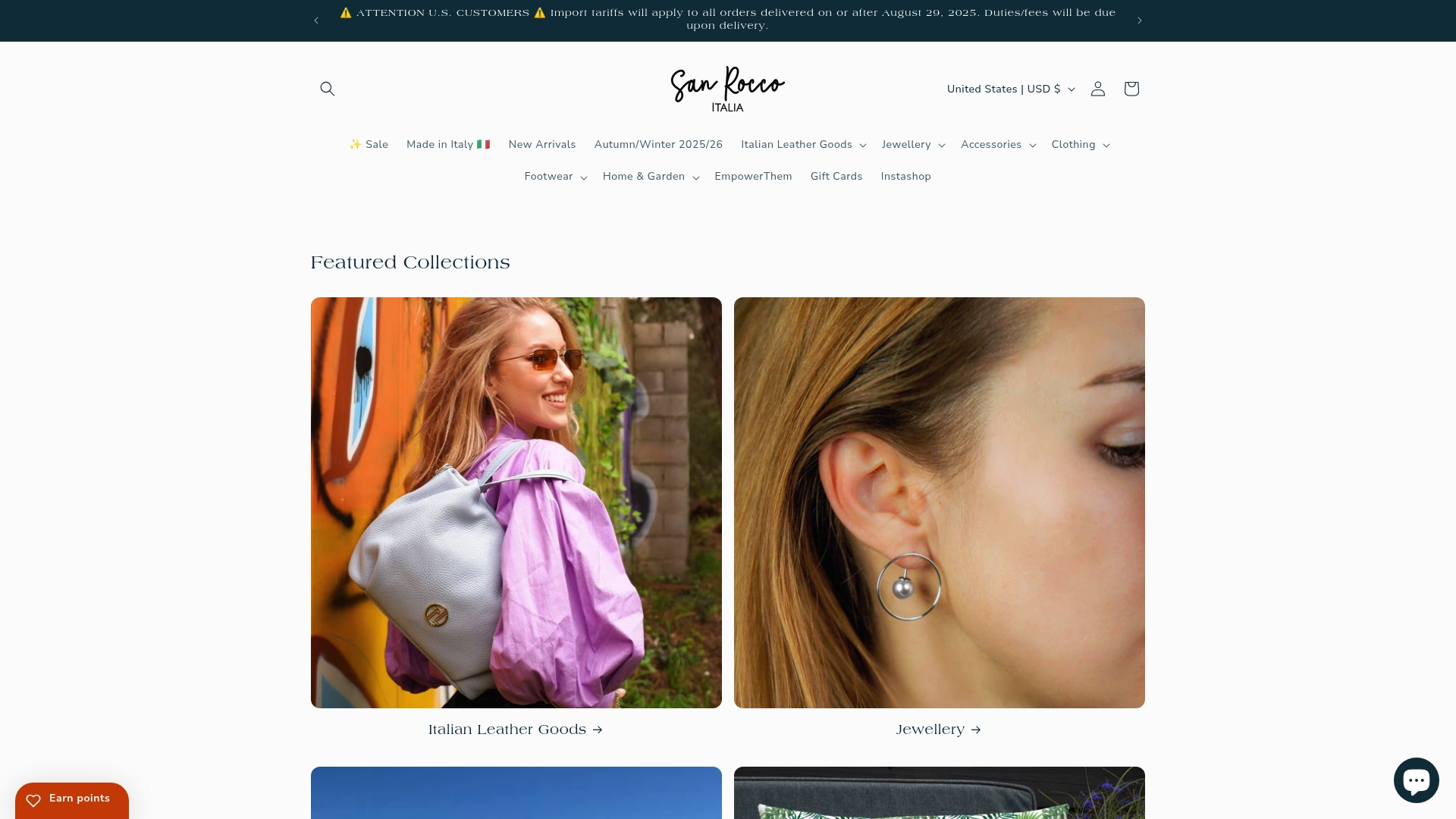
Transform your relationship with luxury leather and experience timeless Italian artistry. Discover how your next cherished piece can capture both your style and your history. Visit San Rocco Italia now to explore our exclusive range and secure a genuine leather item that evolves just for you. Celebrating slow fashion and exceptional quality, now is the perfect time to invest in something truly meaningful. Start your journey today.
Frequently Asked Questions
What is vegetable tanned leather patina?
Vegetable tanned leather patina is the natural transformation that occurs in high-quality leather, enhancing its appearance over time through environmental interactions and personal use. It reflects the leather’s unique journey, developing character and beauty.
How does the vegetable tanning process influence the development of patina?
The vegetable tanning process utilises natural tannins from plant materials, which creates a stable molecular structure in the leather. This allows the leather to interact dynamically with its environment, leading to a rich, evolving patina as it ages.
What are the key characteristics of a well-developed leather patina?
A well-developed leather patina typically features a gradual colour transformation, unique surface variations, increased luminosity, and enhanced visual depth, contributing to the leather’s unique narrative and aesthetic appeal over time.
How can I maintain and appreciate the patina of my vegetable tanned leather?
To maintain and appreciate the patina, protect the leather from extreme conditions, ensure moderate temperature and humidity, and engage with it gently. Regular conditioning with natural oils and careful cleaning can enhance its qualities while allowing it to naturally evolve.
Recommended
- What is vegetable-tanned Tuscan leather and what makes it so special? – San Rocco Italia
- Decoding Elegance: What to Look for When Buying Italian Leather Bags – San Rocco Italia
- What Is Vegetable Tanned Leather? The Italian Craft Unveiled – San Rocco Italia
- The Art of Crafting Italian Leather Bags: From Tradition to Trend – San Rocco Italia

